 |
Love Cyprus ! Cyprus in your heart. in Russian | in Russian |  in English in EnglishMain page | Book hotel |
Perhaps, best site about Cyprus. Cyprus A-Z. Deposit rates in Cyprus up to 11%. Hotel ? Book! |
 |
Love Cyprus ! Cyprus in your heart. in Russian | in Russian |  in English in EnglishMain page | Book hotel |
Perhaps, best site about Cyprus. Cyprus A-Z. Deposit rates in Cyprus up to 11%. Hotel ? Book! |



Main | ▲ | Contact
Copyright © CyprusSite.com. KrAn. All rights reserved. 2004-2016.
 |
 |
|
 |
Kykkos monastery in Troodos Cyprus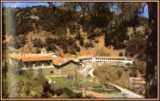 (large picture) (large picture) 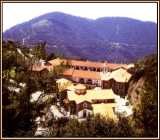 (large picture) (large picture)View of the Monastery The monastery lies on the western side of the Troodos Mountains at an altitude of about 1200 metres above sea level . The nearest villages are Tsakkistra and Kampos in a north-westerly direction , Milikouri in the south and Moutoullas in the east . To the west of the monastery extends a wonderful valley of cedars through which runs the road to Paphos . 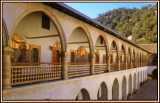 (large picture) (large picture)Balconi with frescoes The monastery is known under the name of Kykkos or the 'Mother of God of Kykkos" , but it is still not known where this name comes from . According to one tradition , the designation 'kykkos' or 'kokkos', is linked with the kermes oak (Latin 'quercus coccifera') which grew in this area a few centuries ago . Another version ascribed the expression 'kykkos' to a bird whose call 'kik-ko, kik-ko' became the name of the monastery . 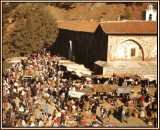 (large picture) (large picture)An older photograph during a festival Historical sources indicate that Kykkos was founded at the end of the eleventh century by the Byzantine ruler Alexios Komnenos I . At that time , Cyprus formed part of the East Roman Empire and the emperor regularly sent his governors to the island . They were given the title of duke . Among them was one of the emperor's most brilliant and highly honoured generals , Manuel Boutoumites . Boutoumites could not endure the oppressive heat and sultriness which prevails in Nicosia in summer , and like many other nobles , moved to cooler places with fresh air on account of his health . In the Middle Ages , this privilege was , of course , reserved for the upper classes on Cyprus . They often travelled to the area of Myrianthousa and stayed there for a while . The area offered them easy access to the nearby mountains and gorges , and they were able to go riding and hunting . One day , during such a summer vaccation , Boutoumites met an old hermit by the name of Isaiah . The latter accompanied him later to Constantinople in order to bring to Cyprus that icon which the Evangelist Luke is said , according to the legend , to have painted just seven years after the Crucifiction and Resurrection of Christ . Originally , this holy icon had been brought from Egypt to Constantinople . Its divine power helped , together with prayers , in the curing of the daughter of Emperor Alexios Komnenos . She had been suffering from an incurable disease , described as a kind of paralysis , the same affliction which later the Duke of Cyprus , Manuel Boutoumites , wanted to fight with the help of the picture of the Virgin Mary . After his return from the imperial palace in Constantinople , together with Isaiah , he brought the sacred icon to Cyprus and , following a divine command , set it up in the place in which the hermit had begun to build a church in the name of the Holy Trinity . In the same place , Isaiah founded a monastery to which he admitted all those who had come to become hermits with him . Therefore , to the present day the monastery is called "the Imperial and Stavropegial Monastery of Kykkos" . The term 'stavropegial' designates a cross lying under the foundation stone . After completion of the monastery , Isaiah became the first abbot . Shortly after his appointment , he began to draft rules under which the monks were to live in order to achieve the salvation of their souls . 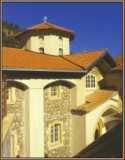 (large picture) (large picture)The dome of the church The iconographic style of the icon of the Mother of God 'Kykkotissa' differs from all other icon types of the Virgin Mary . It shows her with her child . Christ sits on the right side of the Virgin with his naked legs hanging down . At the beginning of the twelfth century , this icon type - 'Kykkotissa' - was adopted by the Orthodox Christian world : by Cyprus , Egypt , Greece and larger areas in the Balkans . In the seventeenth century , thanks to the intellectual and cultural links with Cyprus , the 'Kykkotissa' type was also adopted in Russia . 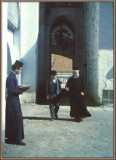 (large picture) (large picture)Studying and instruction Since the mid-eighteenth century , the holy pictures in the icon , those of the Mother of God and of the Child Christ , are veiled and not decked out like the rest of the icons . Nobody dares to look in the face , because many who did so in the past were punished . According to the hagiographic sources , the icon stood open so long as it was in the Emperor's palace . In 1576 , it was encased in a silver gilt cover which was replaced by a new one in 1795 . At that time , the holy icon stood on the left side of the main portal , before the entrance to the iconostasis . For many centuries it is said to have brought about numerous miracles within the monastery , and right down to the present it is the pride and symbol for the salvation of Cyprus . Therefore , not only Christians , but also non-Christians invoke the 'Holy Mother of God of Kykkos !' when they are in difficulties or danger . 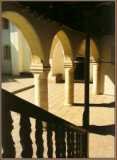 (large picture) (large picture)Stairway to the church In the course of its long history , the monastery of Kykkos and its residents faced many problems . The first catastrophic fire broke out in 1365 . The main church burned down together with many documents and relics . Immediately after , Queen Eleonora , the spouse of the tenth ruler of the French aristocratic family Lusignan , Peter I , had the monastery reconstructed . Conflagrations of similar dimensions took place in 1541 , 1751 and 1813 . Each time , the interior decorations together with the library were destroyed . That is why only a little written evidence of the early history of monastery has been preserved . 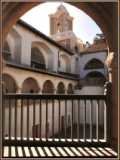 (large picture) (large picture)The Bell-tower from the balcony Scholastic research has shown that Kykkos made a considerable contribution to sacred pictorial art and ecclesiastical literature . This is shown by the large number of manuscripts written on parchment in the twelfth and thirteenth centuries which were used in Kykkos and which are nowadays kept in the French National Library in Paris , the Vatican Library and other major European libraries . Some of these manuscripts furnish valuable information on the abbots and famous persons from Kykkos's past . During Ottoman rule , in Cyprus the old Byzantine tradition of the writing and decoration of books was continued . This can be seen by the numerous liturgical works written by calligraphers and illuminators in an unusual manner which are to be found in the monastery library , the Library of the Patriarchate in Jerusalem , and elsewhere . The illuminations and miniatures in these manuscripts reflect the great influence of the baroque calligraphic schools in Italy which is intermixed with elements of Cypriot popular art (examples in the introduction , fig. 14-16 , p.40f). 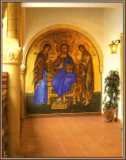 (large picture) (large picture) 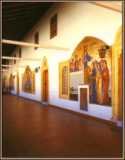 (large picture) (large picture)Frescoes on the balcony walls 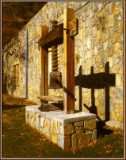 (large picture) (large picture)Wooden compressor Various pilgrims from the West and the East report important details about the past of Kykkos . In 1683 , the Dutchman Cornelis van Bruyn toured Cyprus which at that time was suffering from swarms of locusts . In order to protect the country , Van Bruyn reports , "the inhabitants organised litanies in which they carried round the icon of the Virgin Mary holding Christ in her arms . It is the work of the Apostle Luke which is normally in a monastery called Chicho (Kykkos) with 400 monks . At certain intervals , some monks travelled to Russia and other places in order to carry out the most varied tasks . The monastery is situated on Mount Olympus - the highest on the island . In periods of drought , the icon is carried from the monastery into the church service . The face of the icon is turned to the side from which rain is expected . The same divine service was held against the invasion of locusts , and as soon as the icon was fastened on a pedestal , birds came and descended on the locusts , eating some of them . At that moment , a great gale arose and swept the locusts straight out to sea . The birds which had eaten the locusts had - so it was said - never been seen on Cyprus before and will never return . At the order of the Pasha , nobody was permitted to kill the birds , and if anyone did nevertheless dare to do so , he was put to death . " The Russian monk Basil Grigorovich Barsky , who visited the monastery in 1727 and 1735 , left informative reports on Kykkos . 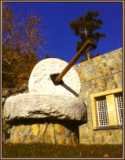 (large picture) (large picture)Mill-stone The main church is a basilika ; the iconostasis may be dated to the 18th. century . Some of the icons in the iconostasis come from the 17th. century . The frescoes in the main part of the restored church were painted recently by the well-known Cypriot painter George Georgiou . The frescoes in the other buildings in the monastery were done a decade ago by Greek , Romanian , Serbian , Bulgarian and Cypriot painters . Impressive are the mosaics , a recent work by the Cypriot artist Philippos Kepolas . 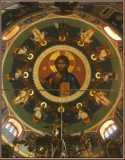 (large picture) (large picture)The dome of the church In the church there is a special room in which a large collection of old icons is kept . The small ecclesiastical museum (a new , large museum is due to be completed shortly) is located in the chapel , near the entrance door of unusual design . Here one can view crosses , relics ,vestments , golden shrines and other objects of historical value . In addition to all these things , there are numerous old books . The finest among them are the printed Russian gospels decorated with precious stones which were presented to Kykkos in the 18th. and 19th. centuries by various Russian church and state dignitaries . 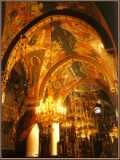 (large picture) (large picture)The inside of the church Under the Turks , it was prohibited to call the faithful to divine service with bells . Only at the end of the 19th. century was it permitted to build a bell tower in which five bells hang . The heaviest one weighs 1280 kilograms , according to an inscription underneath the edge of the bells it was a gift of the Russian Tsar Peter the Great and his wife Catherine . 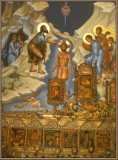 (large picture) (large picture)The Baptism Kykkos nowadays has a valuable library with some 15,000 printed volumes - some dating from even the early 16th. century . The monastery collection includes more than a hundred Greek manuscripts . Among them are parchment fragments from the 10th. century . 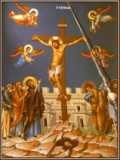 (large picture) (large picture)The Crucifixion The churchyard in Kykkos is accessible through two entrances from the south and east . The buildings around the main church , including the abbot's residence , were erected , together with those on the eastern side , between 1700 and 1755 . The complete restoration of the Kykkos Monastery has been accomplished thanks to the great efforts of the Most Reverend Fr. Nikiphoros , the present abbot of Kykkos . 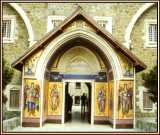 (large picture) (large picture)Entrance to the monastery 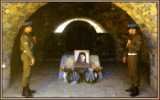 (large picture) (large picture)The tomb of Makarios 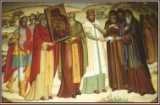 (large picture) (large picture)Wall painting of the icon delivery to the monks 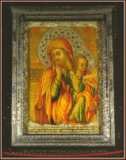 (large picture) (large picture)Icon made by Ioannis Kornaros from Crete , 1801 |